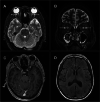Co-occurrence of polyneuritis crainials and visual impairment: a case report and literature review
- PMID: 36585596
- PMCID: PMC9803404
- DOI: 10.1007/s10072-022-06580-0
Co-occurrence of polyneuritis crainials and visual impairment: a case report and literature review
Abstract
Background: Polyneuritis cranialis (PNC) with the disease characteristics of Guillain-Barré syndrome (GBS) in addition to both ocular and bulbar weakness in the absence of limb paralysis or ataxia is defined as an unusual variant of GBS. As evidence of central nervous system (CNS) involvement, visual impairment is an unusual finding complicating with GBS spectrum disorders and has never been reported in patients with PNC.
Methods: We describe a very rare case who clinically presented with progressive multiple cranial nerve palsy and visual impairment. Furthermore, a literature search of concurrent GBS and optic neuritis (ON) as well as PNC attributed to GBS was conducted.
Results: A diagnosis of PNC was considered due to the typical clinical characteristics as well as the presence of cerebrospinal fluid cytoalbumin dissociation and serum antibodies against gangliosides. The clinical manifestations and the bilateral optic nerve involvement in brain magnetic resonance imaging further suggested possible optic neuritis (ON). The patient received treatment with intravenous immunoglobulin followed by short-term use of corticosteroids and finally achieved a full recovery. Thirty-two previously reported cases (17 women, mean age 40) of concurrent GBS and ON and 20 cases of PNC (5 women, mean age 40) were analyzed. We further provided a comprehensive discussion on the potential etiologies, clinical features, therapeutic strategies, and prognosis.
Conclusions: This rare case with the co-occurrence of PNC and visual impairment and the related literature review may help clinicians advance the understanding of GBS spectrum disorders and make appropriate diagnoses and treatment decisions for the rare variants and CNS complications of GBS.
Keywords: Anti-ganglioside antibodies; Guillain-Barré syndrome; Literature review; Optic neuritis; Polyneuritis cranialis; Wakerley classification.
© 2022. Fondazione Società Italiana di Neurologia.
Conflict of interest statement
The authors declare no competing interests.
Figures


Similar articles
-
Polyneuritis cranialis: oculopharyngeal subtype of Guillain-Barré syndrome.J Neurol. 2015 Sep;262(9):2001-12. doi: 10.1007/s00415-015-7678-7. Epub 2015 Feb 26. J Neurol. 2015. PMID: 25712542 Review.
-
Polyneuritis cranialis combined with Horner's syndrome: a rare variant of Guillain Barré syndrome.BMC Neurol. 2025 Apr 16;25(1):162. doi: 10.1186/s12883-025-04169-6. BMC Neurol. 2025. PMID: 40240975 Free PMC article.
-
Severe Guillain-Barré syndrome with concurrent optic neuritis in a pediatric patient: a case report.Front Immunol. 2025 Jan 17;15:1517943. doi: 10.3389/fimmu.2024.1517943. eCollection 2024. Front Immunol. 2025. PMID: 39896802 Free PMC article.
-
Polyneuritis cranialis presenting with anti-GQ1b IgG antibody.J Neurol Sci. 2009 Jun 15;281(1-2):125-6. doi: 10.1016/j.jns.2009.02.340. Epub 2009 Mar 25. J Neurol Sci. 2009. PMID: 19324375
-
Neuropsychiatric debut as a presentation of Guillain-Barré Syndrome: An atypical clinical case and literature review.J Clin Neurosci. 2017 Oct;44:245-249. doi: 10.1016/j.jocn.2017.06.041. Epub 2017 Jul 5. J Clin Neurosci. 2017. PMID: 28688623 Review.
References
Publication types
MeSH terms
Substances
Grants and funding
LinkOut - more resources
Full Text Sources
Medical
Research Materials
Miscellaneous

